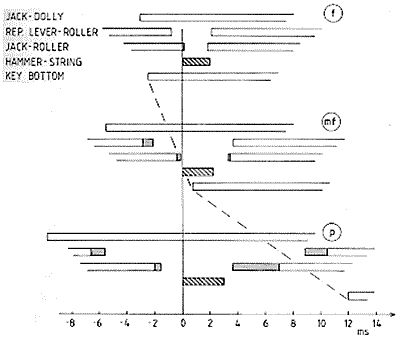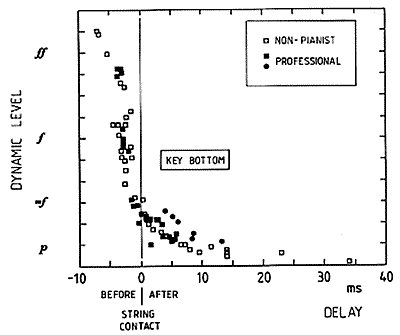
Key bottom and hammerstring contact
[<- Previous]
[Contents of this lecture]
[Next ->]
A close-up of the events at string contact at three dynamic levels shows two interesting facts (see Fig. 4). One observation is of special interest for the pianist. It turns out that at a certain dynamic level, about mezzo forte, the key reaches its bottom position at the same moment as the hammer strikes the string, while at other dynamic levels this synchrony is dissolved. For those of us who don't play the instrument, this observation may not seem very interesting, but every piano player can tell that the bottom feeling of the key is an important feedback from instrument.
 Fig. 4. Influence of dynamic level (p - mf - f) on the timing in the action. The dashed line shows how the moment of key bottom contact is advanced relative to the moment of hammer-string contact, as the dynamic level is raised. The dotted line indicates the shortening of hammer-string contact duration with rising level.
Fig. 4. Influence of dynamic level (p - mf - f) on the timing in the action. The dashed line shows how the moment of key bottom contact is advanced relative to the moment of hammer-string contact, as the dynamic level is raised. The dotted line indicates the shortening of hammer-string contact duration with rising level.
The relation between the moments of key bottom contact and hammer-string contact shows a smooth progression with dynamic level (see Fig. 5). At a soft level (piano) the bottom contact is delayed compared to the hammer-string contact, and at louder levels, the contact is advanced - at forte it occurs even before the hammer strikes the string(s). Interestingly, the magnitude of this shift in timing with level was about the same for an untrained subject as for a professional pianist. This indicates that the phenomenon probably is a combination of the inherent properties of the action and general differences between the ways the key is depressed in forte and piano, respectively ("stroke" vs. "press").
 Fig. 5. Influence of dynamic level on the timing relation between key bottom contact and hammer-string contact. An untrained subject (unfilled symbols) and a professional pianist (filled symbols) are seen to perform almost identically. The dots indicate notes played with very unusual types of touch. The dynamic span ranges from pp to ff, corresponding to 33 dB.
Fig. 5. Influence of dynamic level on the timing relation between key bottom contact and hammer-string contact. An untrained subject (unfilled symbols) and a professional pianist (filled symbols) are seen to perform almost identically. The dots indicate notes played with very unusual types of touch. The dynamic span ranges from pp to ff, corresponding to 33 dB.
One may wonder if the pianist is aware of this variable "delay" between the onset of the note (the hammer strikes the string) and the response in the finger (the key reaches its bottom position). Probably not, even though the delay can reach an order of magnitude (about 20 ms) that it likely affects playing at an artistic level. Presumably, the "bottom feeling" and a compensation for the delay are unconsciously developed during the years of study.
If the piano is not properly regulated, this timing property will be upset. Here, the relevant parameter is the hammer-string distance. A longer hammer-string distance than the nominal value - a normal result of wear - will advance the key bottom contact. An increase in hammer-string distance from a normal 47 mm to 50 mm will result in a shift in the delay comparable to a change in level from mezzo forte to piano (cf. Fig. 5). Most probably a pianist will feel uncomfortable when facing a piano with such an "out-of-tune" regulation, especially if she is accustomed to proper conditions. And, even worse, if the regulation and hence the corresponding delays happens to vary between keys, the artist's performance is likely to be disturbed.
While we are discussing the piano technician's regulation we must also shortly mention the influence of changing the let-off distance. This adjustment determines mainly how long the free flight of the hammer before string contact will last. A very short setting of the let-off (< 1 mm in the midrange and treble) gives the pianist close control of the hammer motion almost up to string level, and there is only a very short interval (< 1 ms) between the moment when the hammer leaves the jack and the moment when it hits the string. Such a close setting is preferred by pianists as it enables a delicate pianissimo-playing under strict control, and it is also claimed to facilitate a powerful fortissimo. Unfortunately, the instrument cannot be left without inspection for any longer period of time in this condition, so the average piano player (and owner) will have to resort to a somewhat more moderate regulation.
[<- Previous]
[Top]
[Contents of this lecture]
[Next ->]
This lecture is one of Five lectures on the
Acoustics of the piano
© 1990 Royal Swedish Academy of Music
 Fig. 4. Influence of dynamic level (p - mf - f) on the timing in the action. The dashed line shows how the moment of key bottom contact is advanced relative to the moment of hammer-string contact, as the dynamic level is raised. The dotted line indicates the shortening of hammer-string contact duration with rising level.
Fig. 4. Influence of dynamic level (p - mf - f) on the timing in the action. The dashed line shows how the moment of key bottom contact is advanced relative to the moment of hammer-string contact, as the dynamic level is raised. The dotted line indicates the shortening of hammer-string contact duration with rising level.

 Fig. 5. Influence of dynamic level on the timing relation between key bottom contact and hammer-string contact. An untrained subject (unfilled symbols) and a professional pianist (filled symbols) are seen to perform almost identically. The dots indicate notes played with very unusual types of touch. The dynamic span ranges from pp to ff, corresponding to 33 dB.
Fig. 5. Influence of dynamic level on the timing relation between key bottom contact and hammer-string contact. An untrained subject (unfilled symbols) and a professional pianist (filled symbols) are seen to perform almost identically. The dots indicate notes played with very unusual types of touch. The dynamic span ranges from pp to ff, corresponding to 33 dB.